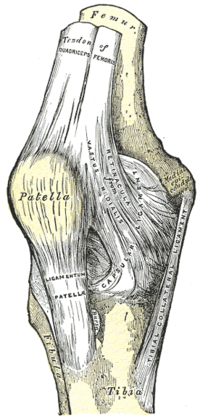
Photo from wikipedia
Purpose To compare the active joint position sense (JPS), muscle strength, and knee functions in individuals who had anterior cruciate ligament (ACL) reconstruction with quadriceps tendon autograft, hamstring tendon autograft,… Click to show full abstract
Purpose To compare the active joint position sense (JPS), muscle strength, and knee functions in individuals who had anterior cruciate ligament (ACL) reconstruction with quadriceps tendon autograft, hamstring tendon autograft, tibialis anterior allograft and healthy individuals. It was hypothesized that when compared to an age and gender-matched healthy control group, subjects who were post-ACL reconstruction would display impaired active joint position sense, knee extensor and flexor strength symmetry and knee function at 1 year post-surgery. A secondary hypothesis was that differences would exist between the quadriceps tendon autograft, hamstring tendon autograft and tibialis anterior allograft groups. Methods Sixty-seven patients with ACL reconstruction and 20 healthy individuals were included. Active JPS reproduction was measured at 15°, 45° and 75° of knee flexion. International Knee Documentation Committee (IKDC) subjective score and one-leg hop test were used to assess the functional status of the patients. Results The JPS detection was different at the 15° target angle between groups ( F 3.86 = 24.56, p < 0.001). A significantly higher proportion of quadriceps tendon autograft group patients failed to identify the 15° active JPS assessment position compared to the other groups ( p < 0.0001). The quadriceps index was lower in patients compared to healthy individuals ( p < 0.001), while the hamstring index was similar (n.s.). The knee functional outcomes were similar between ACL reconstructed groups and healthy controls (n.s.). Conclusion Knee proprioception deficits and impaired muscle strength were evident among patients at a mean 13.5 months post-ACL reconstruction compared with healthy controls. Patients who underwent ACL reconstruction using a quadriceps tendon autograft may be more likely to actively over-estimate knee position near terminal extension. Physiotherapists may need to focus greater attention on terminal knee extension proprioceptive awareness among this patient group. Level of evidence III.
Journal Title: Knee Surgery, Sports Traumatology, Arthroscopy
Year Published: 2019
Link to full text (if available)
Share on Social Media: Sign Up to like & get
recommendations!